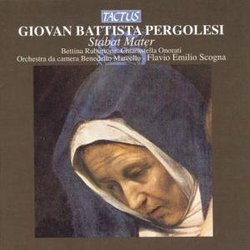| All Artists: Giovanni Pergolesi, Flavio Emilio Scogna, Orchestra "B. Marcello", Bettina Rubortone Title: G.B. Pergolesi: Stabat Mater Members Wishing: 0 Total Copies: 0 Label: Tactus Records Original Release Date: 1/1/2006 Re-Release Date: 7/11/2006 Album Type: Import Genres: Pop, Classical Styles: Vocal Pop, Opera & Classical Vocal, Chamber Music, Historical Periods, Baroque (c.1600-1750), Classical (c.1770-1830) Number of Discs: 1 SwapaCD Credits: 1 UPC: 8007194103526 |
Search - Giovanni Pergolesi, Flavio Emilio Scogna, Orchestra "B. Marcello" :: G.B. Pergolesi: Stabat Mater
 | Giovanni Pergolesi, Flavio Emilio Scogna, Orchestra "B. Marcello" G.B. Pergolesi: Stabat Mater Genres: Pop, Classical
This central Baroque masterpiece receives an authoritative performance by Early Music specialists, using the critical edition of the score realized by Helmut Hucke in 1987. Composed for two female soloists with strings and... more » |
Larger Image |
CD Details
Synopsis
Album Description
This central Baroque masterpiece receives an authoritative performance by Early Music specialists, using the critical edition of the score realized by Helmut Hucke in 1987. Composed for two female soloists with strings and continuo, this work is a setting of the beautiful fourteenth century verses of Jacopone da Todi describing Mary standing at the foot of the cross. It was an audience success from its first performance thanks to the aura of pathos that colors the composer?s last work, as well as by his premature death in 1736, at the age of twenty-six. Born in 1710, Pergolesi was one of the first important composers of comic opera, of which La Serva Padrona is still popular today. The Stabat Mater, written in 1736 for Good Friday services in Naples, became the most frequently printed work of the entire eighteenth century. Other composers often stole from it ? including J.S. Bach in his Psalm Tilge, Höchster, meine Sündern, BWV 1083.

 Track Listings (12) - Disc #1
Track Listings (12) - Disc #1